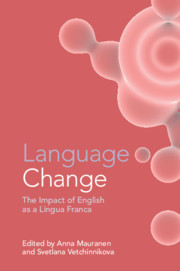Book contents
- Language Change
- Language Change
- Copyright page
- Contents
- Figures
- Tables
- Contributors
- Acknowledgements
- Abbreviations
- Introduction
- Part I Pooling Perspectives
- Part II Zooming in on ELF
- 7 ELF, Language Change, and Social Networks
- 8 ELF and Language Change at the Individual Level
- 9 Are Multilinguals the Better Academic ELF Users?
- 10 The Role of Co-Textual and Contextual Cues for Intelligibility in ELF Interactions
- 11 Exploring the Pragmatics of Computer-Mediated English as a Lingua Franca Communication
- 12 Development of Shared Multilingual Resources in ELF Dyadic Interaction
- 13 The Role of Translanguaging in ELF Advice Sessions for Asylum Seekers
- Index
- References
7 - ELF, Language Change, and Social Networks
Evidence from Real-Time Social Media Data
from Part II - Zooming in on ELF
Published online by Cambridge University Press: 17 December 2020
- Language Change
- Language Change
- Copyright page
- Contents
- Figures
- Tables
- Contributors
- Acknowledgements
- Abbreviations
- Introduction
- Part I Pooling Perspectives
- Part II Zooming in on ELF
- 7 ELF, Language Change, and Social Networks
- 8 ELF and Language Change at the Individual Level
- 9 Are Multilinguals the Better Academic ELF Users?
- 10 The Role of Co-Textual and Contextual Cues for Intelligibility in ELF Interactions
- 11 Exploring the Pragmatics of Computer-Mediated English as a Lingua Franca Communication
- 12 Development of Shared Multilingual Resources in ELF Dyadic Interaction
- 13 The Role of Translanguaging in ELF Advice Sessions for Asylum Seekers
- Index
- References
Summary
This article extends ELF studies towards variationist and computational sociolinguistics. It uses social network theory to explore how ELF is embedded in the social structures in which it is used, and it explores the size and nature of social networks in ELF. The empirical part investigates whether multilingual and often mobile ELF users have larger networks and more weak ties than others, and if they therefore could be more likely to act as innovators or early adopters of change than the other speaker groups. Our empirical material consists of real-time social media data from Twitter. The results show that, statistically speaking, social embedding of ELF creates conditions that favour change. ELF users have larger networks and more weak ties than the other groups examined here. With regard to methods, social embedding needs to be taken into account in future studies, and we illustrate that variationist and computational sociolinguistics offers a useful theoretical and methodological toolbox for this task.
- Type
- Chapter
- Information
- Language ChangeThe Impact of English as a Lingua Franca, pp. 179 - 204Publisher: Cambridge University PressPrint publication year: 2020
References
- 6
- Cited by

